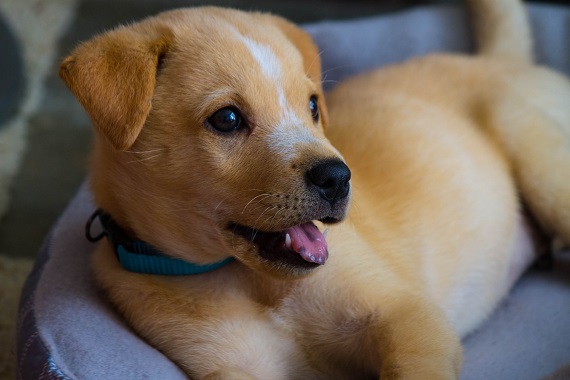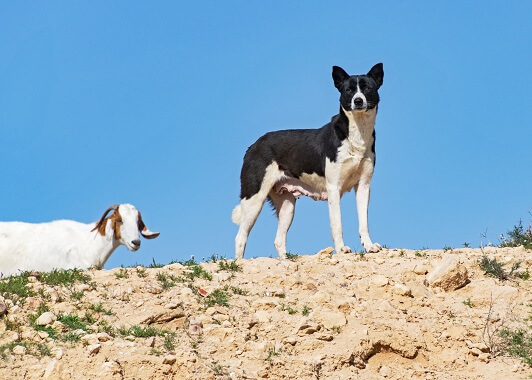
The Canaan Dog is a breed of pariah dog (Canis lupus) that is also known as the Bedouin Sheepdog or Palestinian Pariah Dog. It is one of the oldest and rarest breeds in the world. This herding dog is a descendant from semiwild pariah dogs that have been found in the region now known as Israel since biblical times. These dogs have lived alongside humans for 2,000 years, and are used to guard and herd livestock. However, they were not fully domesticated until the 20th century. A breed program was set up in Israel in the 1930s by Drs. Rudolph and Rudolphina Menzel. A number of these dogs still exist in the wild, although many were eradicated as part of a rabies eradication program. Canaan dogs are medium-sized dogs that have a ‘wild-type’ appearance. They have a wedge-shaped head with upright ears that are set low on their head. Their double coat is short and harsh. These dogs are often white, with large markings in brown, black, or red. Some dogs may be brown or black in color with white markings. They are muscular and very agile and have a square and balanced body. Canaan dogs have a bushy tail that curls over their back. It can also be uncurled and point out straight to assist them with balance when they are moving at speed. Canaan dogs are very agile and can move at speed. They can change direction very quickly and cover a lot of ground very fast. These dogs have a very independent nature because they lived and survived in the wild for centuries. Canaan dogs are also extremely intelligent, good at solving problems and have a strong sense of smell that makes them excellent hunting dogs. They have been used to locate landmines by scent, as well as in tracking, herding, guarding, search and rescue, and some have also been used as therapy dogs. These dogs are intelligent and trainable but must be well socialized. They are often vocal, and their temperament is quite playful. Canaan dogs are very active and become frustrated if they are not kept busy and well-exercised. These dogs are rarely aggressive but don’t like strangers, and will bark if someone or something strange crosses their path. Canaan dogs are intelligent, agile dogs that have survived for centuries in the desert. They have several biological adaptations that have enabled them to survive in often harsh environments in the Middle East. Let’s take a closer look. Canaan dogs have large, pointy-shaped ears that help to radiate excess heat. There are several blood vessels in the ears that carry warm blood from the interior of the body up to the thin skin of the ears, where heat can then be lost to the environment. This helps to keep the body cool during hot weather. Several carnivores from warm climates also have this adaptation, such as the fennec, a desert fox. Its ears are much larger in size than its relative, the arctic fox, that lives in cold, snowy conditions. The pointy ears also have another purpose; they are the best shape for collecting sound! They also have a good range of motion. This helps the Canaan dog to hear sounds far away and either connect with other dogs or avoid predators. Canaan dogs have several behavioral adaptations that have helped them to survive in the desert environment. They are very alert and very quiet, which allows them to find prey and avoid predators. However, they are also very territorial and will sound an alarm if they feel threatened. This vocalization not only warns predators that they have been spotted, but it also warns other pack members who can come to the aid of the caller. A predator is less likely to proceed if it has lost the element of surprise or if it is going to find itself greatly outnumbered. Many social animals make alarm calls to warn their conspecifics that danger is approaching. This allows conspecifics to respond with the appropriate behavior, even if they have not seen the predator themselves. Primates and many bird species use alarm calls as an antipredator adaptation. Canaan dogs are mammals, and so one of their primary characteristics is that they have hair. More interestingly, these dogs have double coats, which means that they have two layers of hair. Each layer of hair has a different function to protect the dog from various elements. The inner layer of fur is like wool and protects from the extreme temperatures of their environment – the heat of the desert during the day and the cold at night. The outer layer is medium length and really thick and helps to repel moisture and dirt. Several subspecies of dogs have double coats, especially those that are from an area with extreme climates, such as the Siberian husky, the Australian shepherd, and the Bernese mountain dog.
Kingdom
Animalia
Phylum
Chordata
Class
Mammalia
Order
Carnivora
Family
Canidae
Genus
Canis
Species
Canis lupus
Subspecies
Canis lupus familiaris
Height
19 – 24 in (48 to 61 cm) at the shoulder
Weight
35 – 55 pounds (16 – 25 kg)
Lifespan
12 – 15 years
Social Structure
In the wild, they live in packs, but many are now domesticated
Status
Domesticated, low numbers in the wild
Natural Habitat
Desert
Average Litter Size
4 – 6
Main food item
Small mammals, garbage
Potential predators
Lions, wolves, and hyenas
The Basics


Interesting Insights from the Canaan Dog!
Ears

Temperament
Double Coat
